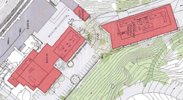



As Berkeley Lab’s laser safety officer, Ken Barat evaluates the set-up of lasers, monitors controls, and provides training. Wanting to share his knowledge with laser users and safety professionals, Barat recently edited a book called “Laser Safety: Tools and Training.” “Previous books have followed a predictable pattern: defining a laser and its biological effects, necessary eyewear, accident cases, non-beam hazards, and laser classification,” explains Barat. “My book provides more practical, hands-on guidance.”
Barat’s outreach efforts have not gone unnoticed. He recently received the 2009 “R. James Rockwell Jr. Educational Achievement Award” from the Laser Institute of America (LIA).
Asked to describe his passion for laser safety, Barat says: "Too many people involved in safety act as policeman rather than finding successful ways to comply with rules and work safely while still getting their job done. To me safety should be a cooperative effort.”
Go to OurSafety for more on the Lab's safety efforts.
 In The News: IMPACT Project Tracks Shifting Gears of Global Warming
In The News: IMPACT Project Tracks Shifting Gears of Global Warming[Popular Science] To predict the unpredictable: That’s the goal of a new government initiative on abrupt climate change. As the atmosphere reels under the influence of greenhouse gases, scientists fear the growing risk of dramatic environmental changes occurring within decades — far faster than current computer models predict. William Collins, head of the climate-science department at Berkeley Lab, calls the possibility of abrupt climate change “a huge threat to the security and stability of our nation and the world.” More>
 Construction: Public Meeting on Seismic Life Safety Phase 2B
Construction: Public Meeting on Seismic Life Safety Phase 2B A CEQA scoping meeting for the Environmental Impact Report for the proposed Seismic Life Safety Phase 2B project at Berkeley Lab will be held at 6:30 p.m. tomorrow at the North Berkeley Senior Center. Public input will be solicited on what is projected to be demolition of outdated and seismically unsafe facilities, seismic improvements to existing facilities, and construction of a new, approximately 43,000 square-foot General Purpose Laboratory building. Employees are welcome to attend the meeting to learn more about the project or provide views on the scope as part of the environmental review and design of the project. More>
 In The News: Genetic Code Sees Double
In The News: Genetic Code Sees Double[Science Magazine] Call it the genetic version of a double-entendre. Scientific dogma dictates that various three-letter combinations of our genetic sequence each "mean" exactly one thing— each codes for a particular amino acid, the building block of proteins. But a team of researchers — including Jamie Cate with Berkeley Lab’s Physical Biosciences Division — has discovered that one of the three-letter combinations in the Euplotes crassus protozoan has two meanings, coding for two different amino acids. Although the find may seem trivial, it poses a major challenge to more than four decades of scientific thinking. More>
 In Memoriam: IT Computer Systems Engineer Ragu Parthasarathy
In Memoriam: IT Computer Systems Engineer Ragu ParthasarathyRagu Parthasarathy, a computer systems engineer for the Financial Systems Group in the Information Technology Division, died on Dec. 25 following a long battle with cancer. Parthasarathy started his career at the Lab in 2000, and during his tenure he contributed to several important financial system development projects. He was known for his cheerfulness, creative technical contributions, and magic tricks. A memorial will be held in late January. Donations in Parthasarathy’s name can be made to Asha for Education (reference “P. Raghunathan”).
Women who work at the Lab are invited to attend a workshop on investing tips specific to their gender. The event takes place from 2 to 4 p.m. on Tuesday Jan. 20 in Bldg. 2-100B, sponsored by HR Benefits and the Berkeley Lab Institute. Go here to register (BLI1039).
 If you think you know what science is and how science works, think again. A new UC Berkeley website called "Understanding Science" paints an entirely new picture of what science is and how science is done, showing it to be a dynamic and creative process rather than the linear — and frequently boring — process depicted in most textbooks. With funding from the National Science Foundation, the site was created as a resource for teachers and the public. Content was vetted by historians and philosophers of science as well as by K-12 teachers and scientists from many disciplines. More>
If you think you know what science is and how science works, think again. A new UC Berkeley website called "Understanding Science" paints an entirely new picture of what science is and how science is done, showing it to be a dynamic and creative process rather than the linear — and frequently boring — process depicted in most textbooks. With funding from the National Science Foundation, the site was created as a resource for teachers and the public. Content was vetted by historians and philosophers of science as well as by K-12 teachers and scientists from many disciplines. More>